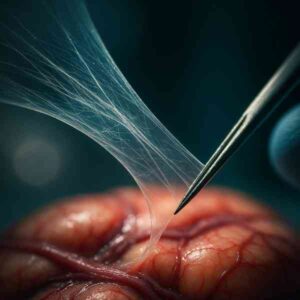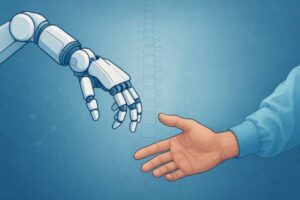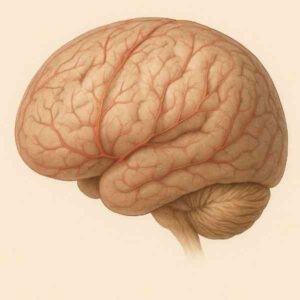“I’m seeing double,” Rita said, sitting across from me. Her eyes were doing a passable impression of a Picasso painting. She was dressed in a white dress with silver streaks, and a grey hairband kept her highlighted fringe off her forehead – one less thing to be seeing double of. “It is unusual for someone in their 30s to have double vision,” I stated. “It’s only when I try and look in a certain direction,” she clarified. I examined her to find that her eyes were slightly misaligned, the right eye being ‘down and out’ – a classic sign of the oculomotor nerve being affected. This is the third among the 12 pairs of cranial nerves. It is also one of the three nerves responsible for moving the eyes. “Oftentimes, diabetes is a cause, but we have to make sure nothing is pressing against the nerve from outside,” I explained to her and her father, who by now was visibly concerned when I pointed out the subtle drooping of the eyelid.
A few days later, they returned with the MRI and CT scans I’d ordered, and as suspected, it showed an aneurysm pressing against the nerve. An aneurysm is an abnormal dilation of an artery due to its wall being weak, causing it to balloon out. “This is what’s causing your problem,” I said, pointing to the 1 cm blob. “Given its anatomy and configuration, it’s best treated by surgery, or else I would have suggested an endovascular route to try and fix it by inserting a flow diverter,” I explained, adding that the risk of rupture is high and that it could sometimes be fatal. After a round of detailed questioning and a couple of second opinions later, they agreed to operate.
On a cool winter morning, we wheeled her into the operation theatre. The sterile air inside the room seeming colder than usual, which can sometimes happen when one is nervous before a tough case. Aneurysms are always roiled with a tempestuous secret. To identify them, to dissect around them, and then to finally clip them can either be a tranquil sea or a tsunami. After fixing the head on a clamp, we opened the skull in the usual fashion, the lightly pulsating frontal and temporal lobes lying exposed in front of me as I gently separated the delicate veil of silver strands holding the two lobes together, my instruments gleaming like silver serpents dancing against the brilliant light of the microscope. The oculomotor nerve had been pushed into a corner by the throbbing crimson ball that appeared more malevolent in reality than on a black and white scan, its fragile pulsing wall threating to rupture at any point and shatter the icy silence of the room. I gained control of the main artery from which it arose and placed a temporary clip on it like a dam, reducing the pressure of blood flowing into the aneurysm, so that I could dissect around it with impunity. “That’s the neck we need to throttle,” I told my assistant, channelling my inner gladiator. A 7 mm miniscule clip, made from the most resilient titanium was brought into play. With steady hands, I placed the prongs precisely across the entire length of the neck, and like the talons of an eagle, closed it shut. A subtle shift, a barely perceptible tightening, and the bulging wall ceased its ominous throbbing. The reddish bloom, once a beacon of impending doom, paled, its dangerous pulse silenced. The flow of life, diverted from its perilous detour, resumed its proper course. The oculomotor nerve was relieved of the burden it was bearing.
Rita made a remarkable recovery and was discharged within a few days. When she returned 3 months later, she gave me a piercing look, her eyes no longer seeing double. The eyelids
were in perfect symmetry. The third nerve was working in sync with the fourth, fifth, and sixth.





18 thoughts on “The Third Nerve”
Super
Very descriptive and easy to understand a very difficult surgery, knowing how notorious aneurysms can be.
Awesome results doc!!
Superb….
That was wonderfully recounted doctor…certainly a serious matter but put across so simply..
Also tells what all cld be the reasons for issues/ symptoms that seem routine and simple…we are more informed what all to watch out for
Certainly a pen wielded as deftly as a knife
Dearest Dr Mazda sir ……..
Your perfect diagnosis after carefully examining the eyes of Rita & pinpointing the specific second nerve which requires your steady hands to fix it is a marvelous way of explaining the nitty gritty details of so complicated Surgery in a simple language is an art of Master in Medicine & Literature 🌹
We readers are more interested you to take us out of OT & try your hands in your other hobbies of Adventurous activities in your Blogs to also explore other non medical side of a surgeon 😎
Of course it’s your prerogative to select your subject but your readers & fans will be very very happy to know more about your accountant, your Bankers, your investment advisor., your CA , your travel buddies etc if you can write on all or any of them we readers can also see your non operational skills 🤣
Love you sir for your multiple Talents
God bless sir ❤️
Dear sir, more and more I read your ventures in Neurosurgeries explained so lucidly and most important, your clinical acumen, makes me “hungry” for the next as it makes me mad to fall in love . You are not only Best Teacher but Great Neurosurgeon and the Best story teller. God Bless you ALWAYS, sir.
Doc.Mazda You just take away the fear n pain from all your patients. I am sure when my forearm is 100% fine ,you will pen an article on me too and my complicated brachial plexus .
Doc… you make it all sound so simple…. Like a breeze !
But of courses, needless to say it’s not !
Thank you for sharing this amazing experiences… achievement !
Blessings your way 🤗
Those who have lost loved ones to a ruptured aneurysm must have read this with bated breath!
Thank you dear Surgeon!
You are a lifesaver!
And I love how you save the best for the last!
Dear Mazda
An insightful article which points out that solutions to most problems in the human body lie in the brain.
Please continue writing about these surgeries
Dr. Mazda, your ability to weave real-life medical drama into compelling stories is truly a gift.
Your writing, like your medical skill, heals and offers hope—thank you for sharing your extraordinary perspectives. God Bless.
Please don’t ever stop writing about your medical cases. I read them with bated breath and marvel at your expertise both with the scalpel and the pen.
Thank you.
Thanks doc for another anecdote of a surgical skill and miraculous success for another patient like me. God bless you and your family.
I consider anyone who goes to u lucky, inspite of their problems. Knowing very well they r in best hands.Thanks for being so sincere for all ur patients. As they say God has no favourites,dr.mazda has no favourites he is equally devoted to healing all who go to him.
I feel your work on your surgery is enormous effort you take personal life habit to go through it and finally its you who is satisfied no matter what the problem could be.
Going thru the article couldn’t figure out what was tougher ..the surgery or the write up??
What a vivid description..picturesque!!
Hello Doctor,
Missed reading your article in the Midday, but this popped up and truly fascinating how you write about the surgeries that you perform. Always look forward to read your columns and now your blog.
Thank you!
Hmmmmmmm Dr Mazda a nice non partial Man for all his patient the same His talking to you alone about you problems solve 50% of your challenge I’m so grateful for Dr Mazda”s life God bless give more strength and keep for this generation